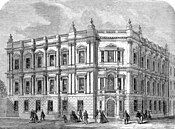Related Research Articles

Southwark is a district of Central London situated on the south bank of the River Thames, forming the north-western part of the wider modern London Borough of Southwark. The district, which is the oldest part of South London, developed due to its position at the southern end of the early versions of London Bridge, the only dry crossing point for many miles. Around 43 AD, engineers of the Roman Empire found the geographic features of the south bank suitable for the placement and construction of the first bridge.
In many countries, a mayor is the highest-ranking official in a municipal government such as that of a city or a town. Worldwide, there is a wide variance in local laws and customs regarding the powers and responsibilities of a mayor as well as the means by which a mayor is elected or otherwise mandated. Depending on the system chosen, a mayor may be the chief executive officer of the municipal government, may simply chair a multi-member governing body with little or no independent power, or may play a solely ceremonial role. A mayor's duties and responsibilities may be to appoint and oversee municipal managers and employees, provide basic governmental services to constituents, and execute the laws and ordinances passed by a municipal governing body. Options for selection of a mayor include direct election by the public, or selection by an elected governing council or board.
An alderman is a member of a municipal assembly or council in many jurisdictions founded upon English law. The term may be titular, denoting a high-ranking member of a borough or county council, a council member chosen by the elected members themselves rather than by popular vote, or a council member elected by voters.

The Metropolitan Board of Works (MBW) was the upper tier of local government of London's metropolis – it upgraded the infrastructure between 1855 and 1889. Also, it had a parks and open spaces committee which set aside and opened up several landmark parks. The metropolis, which the board served, included substantial parts of Middlesex, Surrey, and Kent throughout the 33 years leading up to the advent of county councils. This urban zone lay around the medieval-sized City of London but plans to enact a similar body in 1837 failed. Parliament finally passed the Metropolis Management Act 1855 which dissolved a short-lived building office and a sewers commission and made the Board effective as of December that year. The board endured until it was succeeded by London County Council, as its directly elected, direct successor, in March 1889.
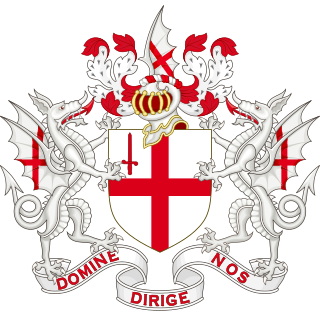
The City of London Corporation, officially and legally the Mayor and Commonalty and Citizens of the City of London, is the municipal governing body of the City of London, the historic centre of London and the location of much of the United Kingdom's financial sector.
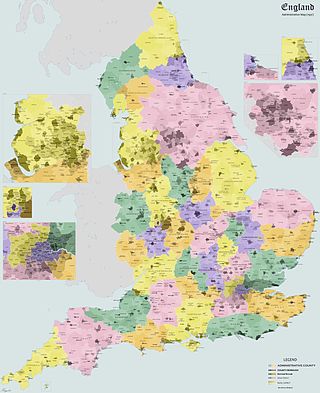
Municipal boroughs were a type of local government district which existed in England and Wales between 1835 and 1974, in Northern Ireland from 1840 to 1973 and in the Republic of Ireland from 1840 to 2002. Broadly similar structures existed in Scotland from 1833 to 1975 with the reform of royal burghs and creation of police burghs.

The Court of Aldermen forms part of the senior governance of the City of London Corporation. It comprises twenty-five aldermen of the City of London, presided over by the Lord Mayor. The Court was originally responsible for the entire administration of the City, but most of its responsibilities were subsumed by the Court of Common Council in the fourteenth century. The Court of Aldermen meets eight times a year in the Aldermen's Court Room at Guildhall. The few remaining duties of the Court include approving people for Freedom of the City and approving the formation of new livery companies, appointing the Recorder of London and acting as the Verderers of Epping Forest.

The Metropolitan Water Board was a municipal body formed in 1903 to manage the water supply in London, UK. The members of the board were nominated by the local authorities within its area of supply. In 1904 it took over the water supply functions from the eight private water companies which had previously supplied water to residents of London. The board oversaw a significant expansion of London's water supply infrastructure, building several new reservoirs and water treatment works.

The Local Government Act 1888 was an Act of Parliament which established county councils and county borough councils in England and Wales. It came into effect on 1 April 1889, except for the County of London, which came into existence on 21 March at the request of the London County Council.
Two sheriffs are elected annually for the City of London by the Liverymen of the City livery companies. Today's sheriffs have only nominal duties, but the historical officeholders had important judicial responsibilities. They have attended the justices at the Central Criminal Court, Old Bailey, since its original role as the court for the City and Middlesex.

The London Government Act 1899 was an Act of the Parliament of the United Kingdom that reformed the administration of the capital. The Act divided the County of London into 28 metropolitan boroughs, replacing the 41 parish vestries and District Boards of Works administering the area. The legislation also transferred a few powers from the London County Council to the boroughs, and removed a number of boundary anomalies. The first elections to the new boroughs were held on 1 November 1900.

The County Borough of Leeds, and its predecessor, the Municipal Borough of Leeds, was a local government district in the West Riding of Yorkshire, England, from 1835 to 1974. Its origin was the ancient borough of Leeds, which was reformed by the Municipal Corporations Act 1835. In 1889, when West Riding County Council was formed, Leeds became a county borough outside the administrative county of the West Riding; and in 1893 the borough gained city status. The borough was extended a number of times, expanding from 21,593 acres (8,738 ha) in 1911 to 40,612 acres (16,435 ha) in 1961; adding in stages the former area of Roundhay, Seacroft, Shadwell and Middleton parishes and gaining other parts of adjacent districts. In 1971 Leeds was the fifth largest county borough by population in England. The county borough was abolished in 1974 and replaced with the larger City of Leeds, a metropolitan district of West Yorkshire.
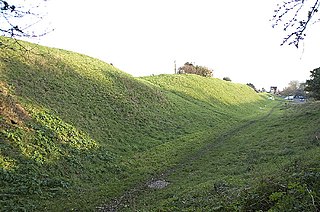
The ancient boroughs were a historic unit of lower-tier local government in England and Wales. The ancient boroughs covered only important towns and were established by charters granted at different times by the monarchy. Their history is largely concerned with the origin of such towns and how they gained the right of self-government. Ancient boroughs were reformed by the Municipal Corporations Act 1835, which introduced directly elected corporations and allowed the incorporation of new industrial towns. Municipal boroughs ceased to be used for the purposes of local government in 1974, with borough status retained as an honorific title granted to some post-1974 local government districts by the Crown.
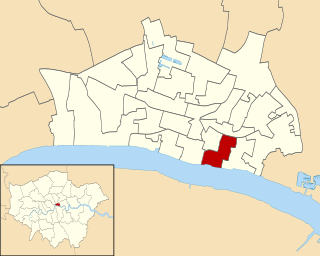
Bridge and Bridge Without is a small ward in the City of London and is named from its closeness to London Bridge. Since boundary changes in 2003, Bridge is bounded by the River Thames to the south; Swan Lane and Gracechurch Street to the west; Fenchurch Street to the north; and Rood Lane and Lovat Lane to the east.
The Royal Commission on the Amalgamation of the City and County of London was a royal commission which considered the means for amalgamating the ancient City of London with the County of London, which had been created in 1889. The commission reported in 1894. The government headed by Lord Rosebery accepted the recommendations of the commission, but when a Conservative government under Lord Salisbury came to power in 1895 the reforms were almost entirely abandoned.
Bridge Without was a historical ward of the City of London situated to the south of the River Thames, which existed between 1550 and 1899. The area of the Bridge Without ward today forms part of the London Borough of Southwark. It was so-called to distinguish it from the ward of Bridge Within which covered the buildings on London Bridge and the nearby north bank of the Thames. Bridge Within since 1978 is formally called Bridge and Bridge Without.

The City of London is divided into 25 wards. The city is the historic core of the much wider metropolis of Greater London, with an ancient and sui generis form of local government, which avoided the many local government reforms elsewhere in the country in the 19th and 20th centuries. Unlike other modern English local authorities, the City of London Corporation has two council bodies: the now largely ceremonial Court of Aldermen, and the Court of Common Council.

Alderman David Henry Stone. His family were the owners of a large amount of land near Lewes for at least three centuries. He was the nephew of Thomas Farncomb the Lord Mayor of London of 1849. Educated at St Olave's Grammar School, in Southwark. He practiced as a solicitor and an attorney from 1839 until 1864.

Sir Thomas Pilkington was an English merchant and Whig politician who served as the Lord Mayor of London in 1689.
Liverpool Town Council existed from 1835 to 1880.
References
Sources
- Commissioners Appointed to Inquire into the Existing State of the Corporation of the City of London (1854). Report, together with the minutes of evidence and appendix. Command papers. Eyre and Spottiswoode for HMSO.
Citations
- ↑ Young, K. & Garside, P., Metropolitan London: Politics and Urban Change, (1982)
- ↑ London Gazette, issue no. 21450, dated 21 June 1853
- ↑ "List of commissions and officials: 1850-1859 (nos. 53-94)". Office-Holders in Modern Britain: Volume 9. 1984. Retrieved 10 March 2008.
- ↑ Not implemented directly by Commission-inspired legislation, the role had been in decline ever since the creation of new docks in the East End and Surrey whose owners would not allow access to the fellowship. An Act of Parliament finally dissolved the fellowship in 1894, giving each former ‘fellowship’ porter compensation. However, ex-porters continued to make claims on the City of London’s benevolence funds for some decades: there were still 16 former Fellowship Porters alive in 1932. REF: -http://zythophile.wordpress.com/2007/11/02/the-forgotten-story-of-londons-porters/.
- ↑ The corporation of the city of London, The Times, 12 May 1854
